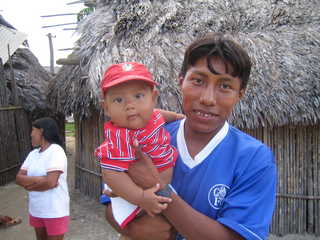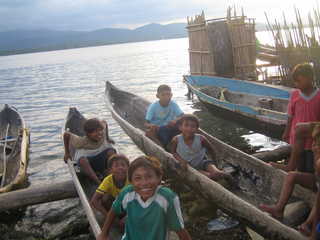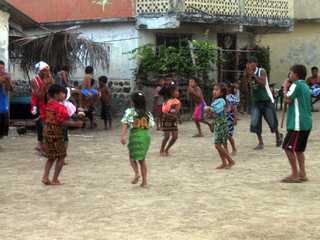Second Visit to San Ignacio TupileThe next day, Tuesday, we've decided to take the movie camera, but not the guitar, as well as a few choice gifts, back to the island. I've gone through all of my clothing and have made a donation bundle of several pairs of pants and shorts, many t-shirts, as well as 3-4 button down shirts, that I think someone on the island will be able to use. We bring a half pound bag of coffee, a Spanish-English dictionary, a box of pencils, and a few dollars with us, as well as a printout of a group picture of a bunch of kids, that we had taken the previous day. Today when we get to the government dock, there is a different Columbian trader there, transferring coconuts and soda crates, but everyone else at the dock recognizes us and smiles and waves and helps us ashore. The first thing we do is stop at the school and tape the photo of the kids up where they will be able to see themselves. Then we walk over to the church and ask around about the "Padre", to whom we'd like to donate the clothing to distribute. Someone across from the not-open church says the Padre lives at the other end of the island, and directs a couple of children to lead us there. They appoint themselves our "official guides" and we set out. So begins our second day on the island, and soon, once again, we have an group of about 10 kids who follow us wherever we go, laughing and playing games along the way. It's already afternoon again, and the Kuna adults have finished their work day, and so are also out and about and virtually everyone we meet greets us with a smile and an "Hola!", or even sometimes a rudimentary English "Good Afternoon!". We make our way through the heart of the village, walking down paths between rows of thatched huts. Here and there Kuna women can be seen in their brightly colored dresses, singly, or in pairs, perhaps sweeping a porch, or holding a baby in their arms. The men, after a day's work, are to be found sitting on benches on the main street, relaxing and chatting, or perhaps mending a fishing net, or working on their house. A few of the buildings are more substantial frame-and-gable construction, but most are thatched huts with palm fronds for roofs and bamboo for walls. A family home might consist of two or three of these huts grouped together, sometimes with a fence surrounding them to form a "private" yard. It's about 1/4 mile to the Padres' house, completely at the opposite end of the island, so in the process of getting there we pass within 100 feet (the approximate width of the island being 200 yards) of nearly all 1300 inhabitants of the island. The people live very close together (though common areas are unusually spacious here) and appear to have developed a good set of rules for keeping the peace and tranquility of the village. We've heard that in general there is a curfew on the islands; that children are in at dark, women by 8:00 pm, and men by 10:00 pm. Foreigners are not allowed, in general, to spend the night on the island, unless they have permission from the "sahila" (pronounced "Silah"), or chief. Social rules like this are understandable given the density of people, and must work pretty well, as once again, almost everyone smiles at us and says hello as we pass and we never see an conflict or argument or anyone scold any of the children. We meet the Padres. There are two of them, Padre Luis from Spain and Padre Freddie, from Costa Rica; they split their worktime between this island's and nearby Playon Chico's churches. It turns out that Padre Luis also plays the guitar, but he takes a pass on getting together as he is very busy every day with his tasks. They speak no English and we speak only limited Spanish, so after about 15 minutes of light chatting, we give them the clothes to distribute to the islanders and bid them adios, receiving a polite blessing. From there, we walk back the way we came with our entourage in tow. Along the way, the kids make it clear that we are approaching a tienda, so we stop and buy four soft drinks, giving one each to our two original "guides" and having four other kids split the other two drinks. As we continue walking towards the main part of the island, who should join us but Anel and Nil, our English-speaking guides from the previous day. We explain to Anel that we would like to make him the official guide, pay him some money, and get his permission to film him. He has no problem with this. He understands completely and rises to the task by answering our questions in English, on camera, as we continue to tour the island. As we make our way past Rudolfo's house, we hear the strains of his guitar and decide to stop by. Bold with our success at enlisting Anel for the "movie", we ask Rudolfo if we can film him and the two girls (his nieces) as they sing the Spanish & Kuna song they did the previous day. Although he's a little disappointed that I didn't bring my guitar, as he would like to learn some "rock and roll", he quickly consents to the filming. So as 8-10 kids are jamming his tiny doorway, we get some great footage of him and the girls singing the tune twice, once in Spanish and once in Kuna. Now we are really on a roll, so we ask Anel if it would be possible to visit with the sahila, the chief of the island. He says "yes, it is no problem, we have two", and the entourage moves off to one sahila's house. We walk past the volleyball court where a vigourous game, between teenage school classes, with the girls in team uniforms, is taking place. Anel leads us through a small maze of alleyways and then sticks his head in a hut and says a few words. He then comes to us and says that this sahila is indisposed but could join us in 15 minutes or so. So we saunter back out to the "main street" where the families are all gathered, perhaps 100 strong, to watch the volleyball. After a few minutes, Anel gets our attention and says that another sahila is ready to see us, and points him out sitting on a chair in front of more substantial house close by. He is dressed regularly, in nice pants and a button down shirt, cap and sandals, and Anel takes us over to meet him. The scene is unusual because of its normalcy. He is just another guy out watching the volleyball, and there is nothing overt to differentiate him from anyone else. Nonetheless, we treat it as a moment of some dignity as, surrounded still by 10 or more kids, with Anel to translate for us, we introduce ourselves. We do our best to convey our pleasure at visiting his beautiful island, and as a token, offer him the bag of coffee as a gift, which he graciously accepts. One of his friends, another man in nice shorts jokes about wanting to take the coffee from him, but in general it seems like the sahila is very pleased by our gesture. He says he is especially glad for the village children to meet us visitors, and that we are welcome here. We ask Anel to convey that we would like to make a donation of a little bit of cash to the village school, and the sahila tells him to take us to the director of the school. Apart from that, we make a little more small talk, and then take our leave of the sahila/chief. Anel walks us along the side of the volleyball court, not that anyone could miss us, with our tag-along group of 10-15 kids and people, to the other side where he then points out the director of the school, who is also watching the game. We introduce ourselves to the director and explain that we want to make a donation to the school. We give him a package of 32 pencils along with a somewhat substantial amount of cash. He is genuinely thankful as he stands up to take the gift and shake our hands. From there we make our way back to the main street and Anel takes us clear back to the other side of the island, where the Padres live, to show us a hotel for foreigners, which is currently closed, but when open is $15/day, including all meals! After that, we return back down the main street to the main part of the island where, coincidentally, the dance group from the previous day has begun gathering for their rehearsal. I ask Anel if he thinks it would be possible to film them, and he says yes, so we go over and negotiate with the leader of the group. He says that for $5 we can film the group, so I give him $10, which makes him quite happy, and everyone takes their places. The group consists of 6 adolescent-to-adult males in modern clothes, and 6 young girls, all around 6-7 of age, wearing traditional dress, and the dance they do is quite remarkable. They all do their parts quite seriously, the men playing pipe flutes and the girls shaking maracas in a steady beat. They repeat the same tune over and over, getting louder and quieter as they line up in one formation, then twist and dance around each other to line up in another formation, doing a hopping, two-step sort of thing in place the whole time. After the dance is over and everyone applauds, the leader asks if we would like to see a second dance, and we say yes, so they line up in a new configuration and start another song. Meanwhile, as we film and photograph it, we still have our entourage of kids, and adults up and down the street are watching the dance along with us. The kids become hams for the camera, imitating the dancers, and mobbing us for photos as the dance reaches its culmination, first getting loud and intense, and then softer and softer until the last step is taken and everyone applauds. It is now starting to be dusk. There are some eye signals exchanged between a few of the adults and Anel, and it suddenly becomes apparent that it is time for us to go, before it gets dark. So we head back to the Gov't Dock, where DITTY is safely parked, having probably been watched over all day. We bid our adieus to Anel and Nil, thanking them each with a bit of money for their work, and the Spanish-English dictionary for Anel, and thanking all of the sweet kids that have been following us around, then step down into the dinghy and start the motor to go to RHAPSODY. As we leave the dock, at least a dozen people are smiling and waving and saying goodbye to us. Wow, what an experience! |


